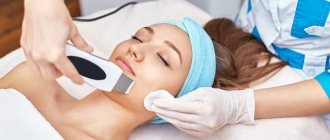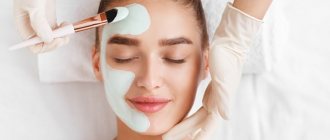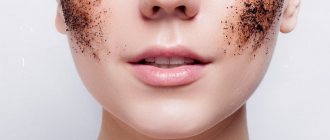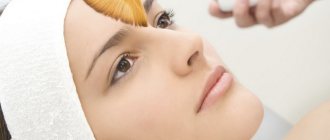Types of facial peels
There are only three of them:
- Mechanical peeling
Involves exfoliating the skin using an abrasive (scrubs, dermabrasion). In professional cosmetology, this type of skin peeling is used less and less. Mechanical peeling is indicated for rough, dense skin with good epithelization.
- Laser peeling (resurfacing, dermabrasion)
An effective but traumatic peeling procedure with a serious recovery period for the skin.
- Chemical peeling
It is most popular among skin peels due to the breadth of indications for its implementation, the possibility of selection according to the depth of penetration and the most suitable composition.
4. Enzyme peeling
Enzyme peels are considered the weakest and most atraumatic, and are sometimes performed before the chemical peel procedure in order to prepare it for deeper penetration of acids in subsequent stages. And also for contraindications to chemical peels.
Laser facial peeling
This type of peeling involves exposing the epidermis to a laser beam. Depending on the type of radiation, as well as the depth of laser penetration, one or another result is achieved.
Contraindications to this type of facial peeling in cosmetology for problem skin:
- oncological diseases;
- cardiovascular diseases;
- infections;
- pregnancy;
- impaired blood clotting;
- presence of fillers in the treated area;
- connective tissue diseases, autoimmune diseases.
Peeling helps in solving a variety of aesthetic problems. To achieve maximum effect, you need to focus on your skin type. In addition, it is important to strictly adhere to the technology of performing the procedure.
Classification of skin peels by depth of damage
Below is a classification of peelings depending on which layer the skin peeling acids penetrate, as well as which peelings represent each group.
Superficial peeling – to the germinal layer of the epidermis (epidermal-dermal junction).
- Glycolic (30 – 50% glycolic acid),
- Milk (10 – 30%),
- Almond (up to 40%, in the case of almond peelings, as a rule, there is a combination with other acids),
- Salicylic (up to 5%, with salicylic peels the depth depends on the percentage and what additional components are contained),
- Pyruvic (up to 50%)
Indications for use: correction of age-related changes (for rejuvenation in all types of aging), acne with inflammation in problem areas of the facial skin (pimples), used when cleansing the skin of sebaceous plugs (comedones) to loosen the epidermis, as well as for age spots.
Potential side effects: post-inflammatory pigmentation, erythema, itching, burning, superficial peeling/epidermolysis
Medium peeling – the entire thickness of the epidermis to the papillary layer of the dermis.
Among the most popular: Jessner peel and its modifications, TCA (trichloroacetic peel), retinol/retinoic (also called “yellow peel”).
Indications for use : affect macrostructural changes in the skin, actively exfoliate, eliminate deeper skin defects (deep pigmentation, post-acne, scars and wrinkles), improve skin texture.
They require a longer recovery period and have an increased risk of scarring and skin dispigmentation.
Deep peeling – up to the reticular layer of the dermis (practically not used in modern cosmetology). The drugs were used on areas with noticeable gross structural disturbances (deep scars, scars).
Currently, aggressive deep peels in cosmetology have practically been abandoned (for example, phenol peels) in favor of safer off-season peels. The reason is the serious complications that arise and the difficult recovery period.
Peels are also available for home use - Home peels are used independently and for professional use - only by specialists in a beauty salon.
Read more about home peeling, what it is, how to choose and use it effectively, here .
Mechanical cleaning
A popular question is how often mechanical peeling is used. Its peculiarity is that it does not affect the deep layers of the dermis and is quite gentle. A procedure is performed to cleanse the skin of dirt and remnants of dead epidermis in order to speed up metabolic processes.
This cleaning is usually done manually using special tools.
There may be minor discomfort during execution, but there is no pain. If your skin is oily and problematic, it will become cleaner and look healthier. During the manipulation, comedones are eliminated, pores can be narrowed, and acne can be removed. Indications for performing the manipulation are enlarged pores and oily skin, the presence of comedones and acne, if there are wen. The procedure is not performed for herpes, allergic dermatosis, if the blood vessels are highly fragile, or if the skin is very thin and sensitive. How often to do facial peeling, check with our cosmetologist during your consultation.
How often can you use homemade skin peeling?
Home peels are superficial and can be mechanical or chemical. Selected according to skin type and problem.
Let's look at specific examples:
DermaQuest facial scrub cleansing gel with alginates is a gel scrub based on algae extracts and jojoba granules for effective cleansing and moisturizing - removes hyperkeratosis and prepares the skin for subsequent stages of care. Intensively “rinses”, increasing the depth of subsequent treatments.
Contains and plant extracts , as well as jojoba granules for gentle effusion of excess stratum corneum.
Recommended for all skin types, including dry, dehydrated and sensitive.
Application: 2 times a week for oily, thick skin or combination skin, 1 time a week for dry and sensitive skin.
DermaQuest pumpkin face mask is a homemade peeling for oily skin with comedones and enlarged pores.
Steaming mask with antibacterial effect for deep cleansing of the skin: dissolves comedones, draws out inflammatory elements and promotes their maturation, removes inflamed acne. Active lymphatic drainage. Gives the skin a well-groomed, neat appearance.
Application: intervals between procedures are 1 week.
— Is it possible to do chemical peeling at home?
— Cosmetologists, as a rule, do not recommend doing home facial peeling using chemicals, because they often encounter complications that patients receive as a result of such amateur activities. Manufacturers of cosmetics, on the contrary, promote their products and convince them that chemical peeling is possible at home.
I think that chemical peeling can be done at home only if several conditions are met:
- home facial peeling should be gentle and superficial (you can only use AHA peels - an alpha-hydroxy acid group of peels in the form of a gel or foam);
- instructions for using peeling must be strictly followed;
- two weeks before peeling, you should not use other abrasive or invasive techniques, medications or cosmetics that affect skin permeability.
How often can I have a professional chemical peel?
The frequency depends on both skin type and peeling depth.
Deep peeling is a medical procedure performed by a doctor with the participation of an anesthesiologist. Patients go to a special cosmetology clinic. As a rule, it is carried out once, because Rehabilitation is complex, and the rehabilitation period itself can take several months.
Medium peeling – is carried out in a course of up to 4 – 6 procedures, once a month, a course once a year.
Superficial peeling – a course of up to 10 procedures, performed once every 7-10-14 days (depending on the skin, how quickly regeneration proceeds and the selected chemical composition). The course is conducted 1–2 times a year.
Read about the types of peelings and choosing the right one for you in the article “Which facial peel to choose” here .
Other factors influencing the frequency of peelings:
- Age. The rate of skin restoration corresponds to age; young skin has good regenerative abilities; with age, processes slow down. Therefore, the breaks between procedures should increase.
- Individual characteristics. Some clients have sensitive skin. Procedures are carried out after detailed consultation about personal data, contraindications, what results to expect and how to help the skin recover, preferably after a sensitivity test.
Carrying out special skin tests allows you to avoid individual undesirable reactions (from peeling to redness and erosion).
To do this, you need to apply a small portion of peeling to the area of the skin of the cheek closer to the ear, neutralize/rinse off after a few minutes (according to the protocol). The next day, ask the client about reactions to these products.
- Skin type. The thinner the skin, the less often exfoliation is performed and the need to prepare the skin for peeling increases.
- Skin preparedness. Preliminary application of creams and serums with acids, as well as sunscreens to protect the skin from post-inflammatory pigmentation allows the procedure to be carried out effectively and comfortably.
Everything you need to know about peeling
It seems that everyone around is already doing peelings. It's time to finally find out: what is it? How often can I do it? Who is it suitable for? And what types are there?
What is peeling?
Peeling is a procedure for deep cleansing the skin using cosmetics containing acid. Its technology is simple: acid exfoliates old epidermal cells and stimulates the formation of new ones. In English, to peel translates as “removing the peel,” which is what happens to the skin during the peeling process.
Is it safe?
The exfoliation process is completely natural for our skin. Usually it occurs within 28 days: some cells die, new ones take their place. The natural process of self-renewal slows down over time, chemical peeling stimulates and makes it more effective: the skin is deeply cleansed and quickly restored. You get beautiful, glowing, smooth skin.
What is the result?
Each type of peeling solves its own problems: superficial, medium, deep. At a young age, superficial treatment is often performed to refresh the skin, get rid of fatigue and dullness. Or deep peeling to solve aesthetic imperfections. After 30, the procedure is recommended as anti-aging therapy. But only a professional doctor will help you choose a peeling for your skin type. Peeling is capable of:
- reduce wrinkles;
- tighten and cleanse pores;
- cure acne;
- eliminate small scars, scars, acne;
- remove pigment and age spots;
- reduce excess oily skin;
- smooth out skin texture.
In some situations the procedure is useless. If you have skin ptosis, burst blood vessels, or serious scars, peeling will not remove them. But in Lesante there are other types of treatments to combat problem skin.
Everything can't be that perfect, can it?
In general, peeling has truly become a cosmetic panacea for the most common aesthetic problems. But it was not without its drawbacks:
- After the procedure, redness and peeling of the skin is inevitable.
- Rehabilitation after the procedure takes several hours, but deep peeling requires a longer recovery: up to 1 week.
How often can I do it?
Acid surface peeling is usually carried out in a course of 5-10 procedures, the interval between sessions is 2 weeks. Then you can carry out a maintenance procedure every 3-6 months.
Medium peeling is carried out once a year in a course of 3-4 procedures.
Deep peeling is the most serious, the process burns the top layer of skin. It is recommended to do it no more than three times in a lifetime.
Acid-free peels usually contain herbal products and are the lightest type of peel and can be done once a week at home.
How to behave after the procedure?
To get the right result after peeling, you should take care of your skin at home. The most important thing is to avoid exposure to ultraviolet radiation on your face for two weeks. In the city, use a cream with protection of 10.15 SPF, on a beach holiday 30-50. Wash your skin (not with soap) in the morning and evening, dry yourself carefully, patting with a towel. At the medical aesthetics center “Lesante” you can purchase professional Dermaceutic post-peeling care. At a free consultation, a cosmetologist will select the appropriate cream, serum or gel for you.
Only have peeling performed by a qualified specialist. Otherwise, you risk getting hired by an illiterate worker without proper education and getting undesirable consequences: hyperpigmentation, acne, rosacea. In Lesante, peeling is carried out by doctors with 10 years of experience and only after a mandatory consultation.
— What complications can arise after peeling at home and how to deal with them?
— There can be a lot of complications, but encountering them can be avoided if you pay attention to the indications and contraindications for the use of cosmetics intended specifically for home use.
And, I repeat, strictly follow the instructions. Unfortunately, many patients tend to violate the rules of use - for example, leave the product on longer, instead of the recommended 10 minutes, leave it for the entire 15 - “so that there is definitely an effect.” As a result, the effect will not increase, but, on the contrary, unforeseen problems will arise. If the instructions say “if you feel a burning sensation, remove the product immediately,” then you should not ignore this warning and stoically endure until the last. You should not take such liberties during home peeling.
There is no need to eliminate complications on your own; it is better to consult a doctor immediately. The most common complication after peeling is pigmentation, which you have to put up with for several weeks or months. Pigmentation occurs, among other things, due to non-compliance with the rules of post-peeling care.
— That is, you do not recommend doing medium and deep types of peeling at home?
- I absolutely do not recommend it. If the product is intended for superficial peeling, it means that it will act exclusively in the upper, stratum corneum layer of the skin; accordingly, even if something goes wrong, the risk of side effects is very small. Superficial home facial peeling does not require a rehabilitation period - everything goes unnoticed, after which only slight peeling of the skin is possible.
Medium peeling acts down to the basal layer of the skin, and deep peeling completely destroys the basal layer and affects the dermis. Medium and deep peels are not always easy to apply, and most importantly, they have a rehabilitation period that can only be carried out under the supervision of a doctor. Some types of deep peeling can only be performed by plastic surgeons and only in specialized medical institutions!









